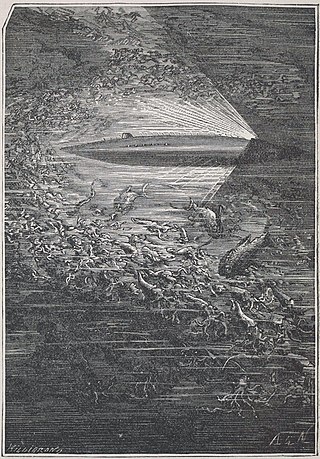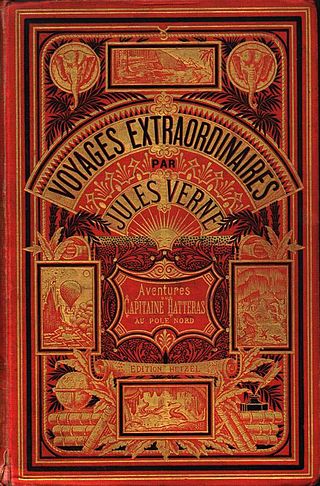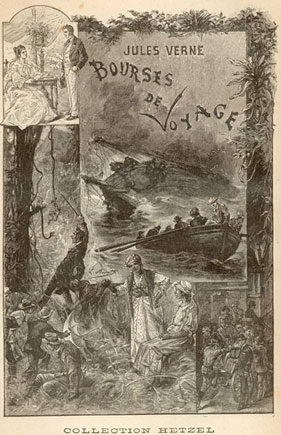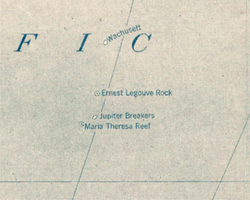
Twenty Thousand Leagues Under the Seas is a classic science fiction adventure novel by French writer Jules Verne.

Nautilus is the fictional submarine belonging to Captain Nemo featured in Jules Verne's novels Twenty Thousand Leagues Under the Seas (1870) and The Mysterious Island (1874). Verne named the Nautilus after Robert Fulton's real-life submarine Nautilus (1800). For the design of the Nautilus, Verne was inspired by the French Navy submarine Plongeur, a model of which he had seen at the 1867 Exposition Universelle, three years before writing his novel.

Captain Nemo is a character created by the French novelist Jules Verne (1828–1905). Nemo appears in two of Verne's science-fiction books, Twenty Thousand Leagues Under the Seas (1870) and The Mysterious Island (1875). He also makes a brief appearance in a play written by Verne with the collaboration of Adolphe d'Ennery, Journey Through the Impossible (1882).

Gustave Flourens was a French Revolutionary leader and writer, son of the physiologist Jean Pierre Flourens. He was also the elder brother of Émile Flourens, who became minister of foreign affairs under the Third Republic.

Raphael Semmes was an officer in the Confederate Navy during the American Civil War. Until then, he had been a serving officer in the US Navy from 1826 to 1860.

The Voyages extraordinaires is a collection or sequence of novels and short stories by the French writer Jules Verne.

In Search of the Castaways is a novel by the French writer Jules Verne, published in 1867–68. The original edition, published by Hetzel, contains a number of illustrations by Édouard Riou. In 1876, it was republished by George Routledge & Sons as a three volume set titled A Voyage Round The World. The three volumes were subtitled South America, Australia, and New Zealand. As often with Verne, English translations have appeared under different names; another edition has the overall title Captain Grant's Children and has two volumes subtitled The Mysterious Document and Among the Cannibals.

The Ernest Legouve Reef is a phantom reef supposed to be located in the South Pacific, south of French Tuamotu Islands and east of New Zealand. Krauth reports that it is situated at 35°12′S150°40′W.

Tom Ayrton is a fictional character who appears in two novels by French author Jules Verne. He is first introduced as a major character in the novel In Search of the Castaways (1867–1868). He then reappears in a later novel, The Mysterious Island (1874), in which his fate, left unknown at the ending of the previous novel, is resolved, and during the course of which his character undergoes change and achieves a redemption.

Mysterious Island is a 1961 science fiction adventure film about prisoners in the American Civil War who escape in a balloon and then find themselves stranded on a remote island populated by giant and tiny animals.

Mysterious Island is a USSR film adaptation of the 1874 novel The Mysterious Island by Jules Verne.
Mysterious Island is a Canadian and New Zealand television series based on Jules Verne's 1875 novel L'Île mystérieuse. It ran for one season in 1995.

Lord Glenarvan is a fictional character that appears in Jules Verne's 1868 novel In Search of the Castaways and then briefly appears in The Mysterious Island (1875). He is a wealthy Scottish noble married to Lady Glenarvan.

Mysterious Island is a 1951 American 15-chapter movie serial from Columbia Pictures, the studio's 46th, that stars Richard Crane, Marshall Reed, Karen Randle, and Ralph Hodges. It is an adaptation of Jules Verne's 1874 novel, The Mysterious Island. As in the original story, which was Verne's follow-up to Twenty Thousand Leagues Under the Sea, this serial is set in 1865. However, Columbia's screenwriters added alien Mercurians as an additional set of villains. The serial has been labeled a space opera version of Verne's novel.

Travel Scholarships is a 1903 adventure novel by Jules Verne.

Godfrey Morgan: A Californian Mystery, also published as School for Crusoes, is an 1882 adventure novel by French writer Jules Verne. The novel tells of a wealthy young man, Godfrey Morgan, who, with his deportment instructor, Professor T. Artelett, embark from San Francisco, California, on a round-the-world ocean voyage. They are cast away on an uninhabited Pacific island, where they must endure a series of adversities. Later, they encounter an African slave, Carefinotu, brought to the island by cannibals. In the end, the trio manage to work together and survive on the island.
The 37th parallel south is a circle of latitude that is 37 degrees south of the Earth's equatorial plane. It crosses the Atlantic Ocean, the Indian Ocean, Australasia, the Pacific Ocean and South America.

Jules Verne's Mysterious Island is a 2012 adventure film directed by Mark Sheppard, very loosely based on Jules Verne's 1875 novel of the same name. It premiered on Syfy on February 11, 2012. The film was released on DVD on May 29, 2012.

The Children of Captain Grant is a 1936 Soviet adventure film directed by Vladimir Vaynshtok and David Gutman and starring Nikolai Cherkasov, Ivan Chuvelyov and Yuri Yuryev. It is an adaptation of the 1868 novel In Search of the Castaways by Jules Verne. The film was popular on its release, and was followed in 1941 by another Verne adaptation Mysterious Island. In the 1860s, two Scottish children go on a global search for their missing father, the sailor Captain Grant.





















